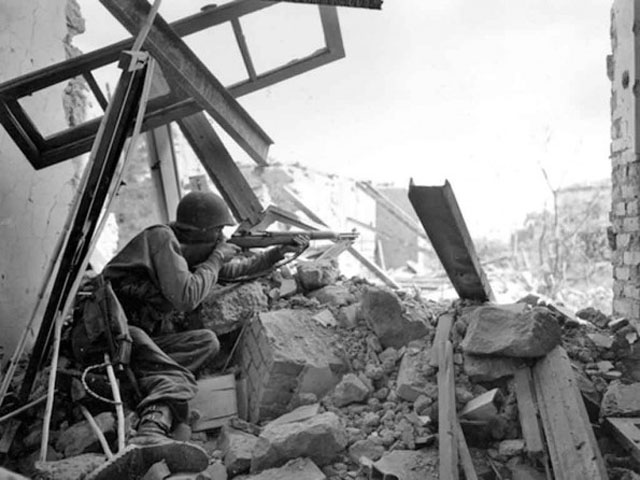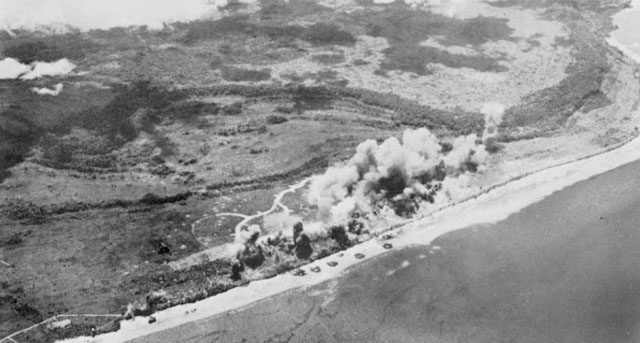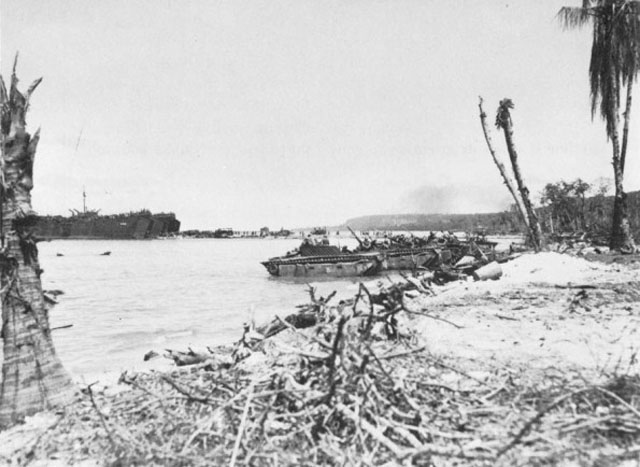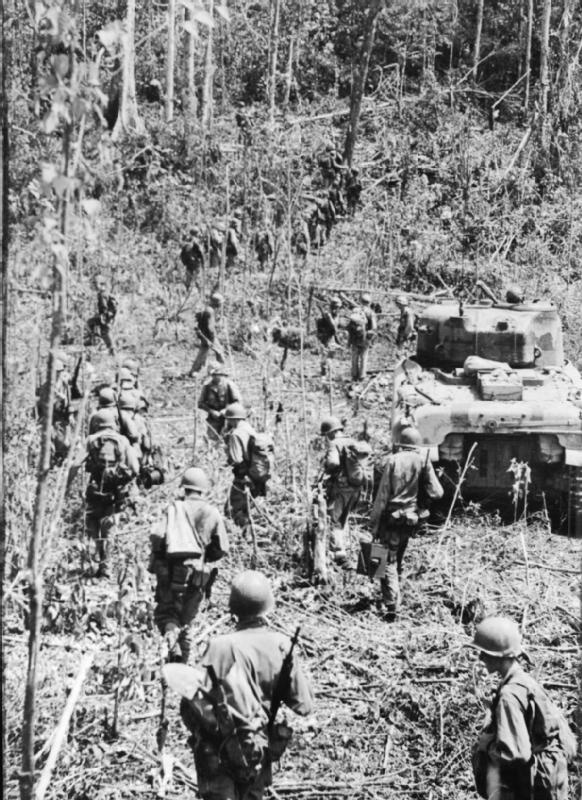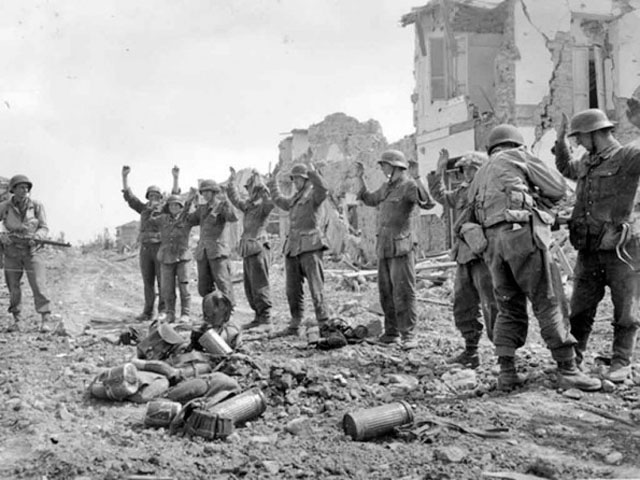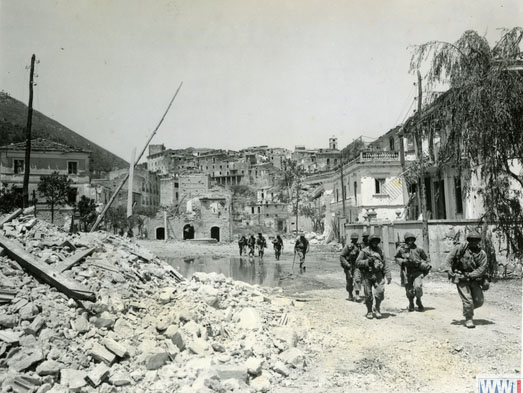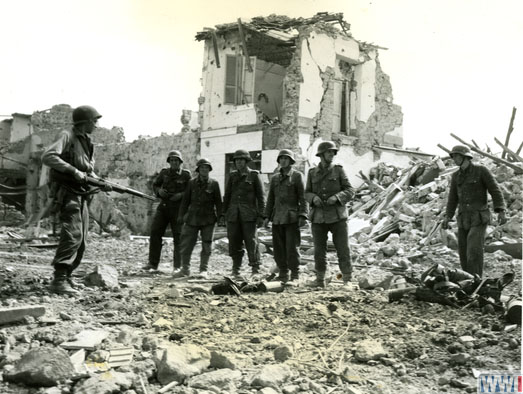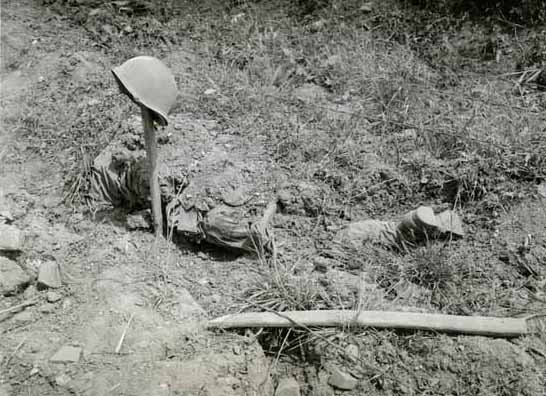Air Operations, Carolines
In the largest mission against the target to date, 24 VII Bomber Command B-24s and 52 41st Medium Bomb Group B-25s attack Ponape Island.
[Air Operations, CBI
BURMA- 157th Heavy Bomb Group B-24s attack Nyaung-u and Pakokku.
- 24 14th Air Force P-40s armed with aerial rockets attack military targets at Nanchang, and warehouses and military targets in the Puchi area.
- 23rd Fighter Group P-40s down 3 Japanese fighters near Yochow during the afternoon.
Air Operations, Europe
RAF BOMBER COMMANDEvening Ops:
- 331 aircraft are sent to attack the military camp at Bourg-Léopold, Belgium. In this total are 267 Halifaxes, 56 Lancasters and 8 Mosquitos. 1 Oboe-aimed target indicator falls right on the target and the bombing that follows causes severe damage to the camp.
- 162 Lancasters and 8 Mosquitos of Nos. 1, 3 and 8 Groups attack the Rothe Erde railway yards at Aachen. The railway lines at the yards, which were not seriously hit in the raid two nights previous, are now severely damaged and all throught traffic is halted. A large percentage of delayed-action bombs are dropped on this raid. The local people are impressed that the whole raid lasted only 12 minutes.
- 12 Lancasters are lost.
- 100 Lancasters and 4 Mosquitos are sent to attack the railway junction and workshops at Nantes. The first 50 Lancastes bomb so accurately that the Master Bomber orders the remainder of the force to retain their bombs.
- 1 Lancaster is lost.
- 78 Lancasters and 5 Mosquitos of No. 8 Group attack the airfield at Rennes in good visibility. The marking is good and the bombing very accurate. Much damage is done to the airfield installations and there is a large explosion, probably the bomb dump.
- 272 aircraft including 208 Lancasters, 49 Halifaxes and 15 Mosquitos carry out raids on 5 coastal battery positions on the French coast. All targets are bombed satisfactorily.
- 1 Lancaster and 1 Mosquito are lost.
- 23 Mosquitos are sent to Berlin, 6 to D¨sseldorf, 60 aircraft lay mines from Le Havre to the Gironde River, 10 aircraft are on Resistance operations, and there are 28 Serrate and 10 Intruder patrols, and 7 RCM and 7 OTU sorties.
- 2 Intruder and 1 Serrate Mosquitos are lost.
Aachen Marshalling Yards |
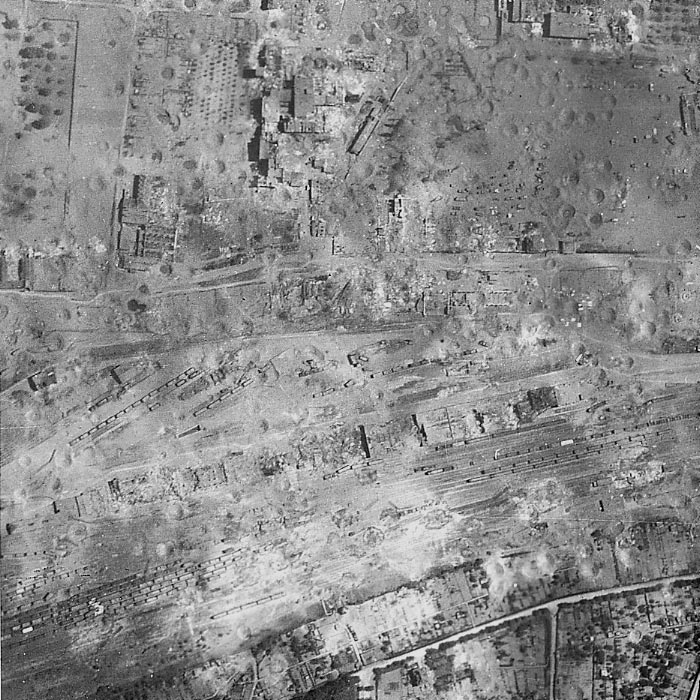 |
FRANCE:
- 36 3rd Bomb Division B-17s and 18 2nd Bomb Division B-24s, respectively, attack gun emplacements at Fecamp and the town of St.-Valery with the aid of H2X equipment.
- 102 3rd Bomb Division B-17s attack aircraft-industry targets and a marshalling yard at Strasbourg.
- 69 3rd Bomb Division B-24s attack the Woippy Airdrome.
- USAAF escort pilots down 34 Luftwaffe fighters over France between 1045 and 1430 hours, but mostly in a major aerial engagement.
- 8th Air Force heavy bombers attack briefed targets and several targets of opportunity as follows: 150 1st Bomb Division B-17s attack a chemical plant at Ludwigshafen; 125 1st Bomb Division B-17s attack a marshalling yard at Mannheim; 43 1st Bomb Division B-17s attack targets of opportunity; 98 3rd Bomb Division attack a marshalling yard at Karlsruhe; 145 2nd Bomb Division B-24s attack a marshalling yard at Saarbrucken; 66 2nd Bomb Division B-24s attack a marshalling yard at Neunkirchen; and 72 2nd Bomb Division B-24s attack a marshalling yard at Kons Karthaus.
- 19 B-17s and 5 B-24s are lost
- USAAF fighter pilots down 4 Luftwaffe aircraft over Germany.
- 24 56th Fighter Group P-47 fighter-bombers attack a barge convoy.
FRANCE:
- Nearly 590 IX Bomber Command B-26 and A-20 sorties, and several hundred P-47 sorties are mounted against marshalling yards, rail lines, and bridges.
ITALY:
- 12th Air Force B-25s and B-26s attack lines of communications running through and around Orvieto.
- XII TAC A-20s attack dumps.
- XII TAC fighter-bombers continue to hunt for motor vehicles, attack bridges, strafe and bomb gun emplacements, and provide direct and close support for the Allied ground forces.
FRANCE:
- In southern France, nearly 700 15th Air Force B-17s and B-24s attack the Montpellier and Salon-De-Provence Airdroms, and marshalling yards at Avignon, Marseille, Montpellier, and Nimes.
- 15th Air Force B-17s attack a marshalling yard at Avignon.
- 15th Air Force heavy bombers attack port facilities at Razanac.
Air Operations, Japan
2 28th Composite Bomb Group B-24s reconnoiter and attack Ushishiru Island.
[Air Operations, New Guinea
- At first light, in support of US Army landings at Bosnik on Biak Island, 12 XIII Bomber Command B-24s based in the Admiralty Islands attack beach defenses. At 0700, 25 XIII Bomber Command B-24s supplement naval gunfire when they also attack beach defenses at Bosnik. US Army ground troops begin landing at Bosnik at 0715 hours under air cover provided by 4 17th Reconnaissance Squadron B-25s.
- Between 1103 and 1150, 77 V Bomber Command B-24s attack Biak’s three airfields—Sorido, Mokmer, and Borokoe. Scheduled attacks by 348th Fighter Group P-47 fighter-bombers are suspended in the face of bad weather between Hollandia and Biak, and no USAAF fighter appears over Biak until after 1100 hours. Nevertheless, throughout the day, V Bomber Command B-25s and A-20s mount scheduled strikes and provide on-call support for the ground troops, and V Fighter Command fighters are available from 1100 hours on. Throughout the day, 1 A-20 is lost to ground fire.
- Beginning at 1100 hours, small flights of Japanese fighters and bombers attack the Biak invasion fleet with negligible results. One burning twin-engine bomber inadvertently strikes a USN submarine chaser, killing two and injuring eight crewman, and starting fires that are soon quenched.
- 380th Heavy Bomb Group B-24s based in Australia attack the airfield at Babo.
- 38th Medium Bomb Group B-25s temporarily based at the Merauke airfield (on the south New Guinea coast) attack the airfields at Babo and Otawiri at minimum level.
- V Bomber Command B-25s and A-20s, and V Fighter Command fighter-bombers complete approximately 170 sorties against targets in the Wewak area.
- 348th Fighter Group P-47s down 4 Ki-43 'Oscar' fighters and 1 Ki-61 'Tony' fighter over Biak Island between 1630 and 1645 hours.
Battle of the Atlantic
Liberator 'S' of No 59 Squadron RCAF attacks a surfaced U-boat, U-292, with six depth charges in a good straddle. Following the explosions the bows of the U-boat are seen to rise before she sinks on an even keel.
| Class | Type VIIC |
| CO | Oberleutnant zur See Werner Schmidt |
| Location | Norwegian Sea, NE of Shetlands |
| Cause | Air attack |
| Casualties | 51 |
| Survivors | None |
CBI
BURMAIn the Myitkyina area troops of the 2nd Marauder Battalion, reinforced by the 209th Engineer Combat Battalion, are engaged in hard fighting with Japanese units south of Charpate, trying to get to Radhapur. They do not reach their objective and suffer heavy losses.
On the Salween River front, Chinese troops secure the Huei-jen bridge and have elements get to within 5 miles of Hongmoshu. The monsoon rains limit operations by both sides.
CHINAThe Japanese begin the second phase (TOGO) of the ICHI GO operations moving 2 divisions into the region east of the Hsiang River, in southern China.
[Italy
Artena is held by 3rd Division despite German counterattacks. Units of the 88th Division reach Roccagorga and farther north the French capture Amaseno, Castro dei Volsci and Monte Siserno.
In the 8th Army sector in the Liri Valley Canadian units attack Ceprano and the British 6th Armored Division moves toward Arce supported by the Indian 8th Division.[MORE]
[New Guinea
TF HURRICANE, consisting largely of the 41st Division, less the 163rd RCT, lands on Biak Island, in the Schoutens group, 150 miles nortwest of Wadke in the big Geelvink Bay and 900 miles from the Philippines. There is the usual preliminary bombardment, in this case by cruisers of Rear-Adm William Fechteler's squadron, before the men of 41st Infantry Division under Gen Horace Fuller land near Bosnek. Against token resistance the 186th Infantry secures the initial beachhead and a trail over the ridges to an inland plateau north of Bosnek. The 162nd Infantry starts westward toward the airfields, overcoming opposition in the Parai Defile to reach Parai. At first there is little resistance but this is misleading, for the Japanese garrison at 11,000 men (Col Kuzume Naoyuki) is just a little weaker than the attack force. Gen Fuller, commander of the 41st Division and of TF HURRICANE, takes command ashore. The close escort for the landing ships is provided by cruisers and destroyers led by Adm William Fechteler and as in the other landings on the north coast Adms Victor Crutchley and Russell Berkey are in support. PT-339 is sunk by US forces after being damaged running aground in western New Guinea.
In the Wadke-Sarmi area, the US 158th RCT attack on Lone Tree Hill makes little progress. The Japanese begin a series of attacks against the beachhead. The Americans are fighting well-trained and disciplined Japanese troops who are experts at camouflage. The American attack collapses into a series of uncoordinated assaults.
[Pacific
The British submarine Templar sinks the Japanese cargo ship Tyokai Maru (2128t) in the Strait of Malacca.
[Images from May 27, 1944
|
|
|
|
|
|
|
|
